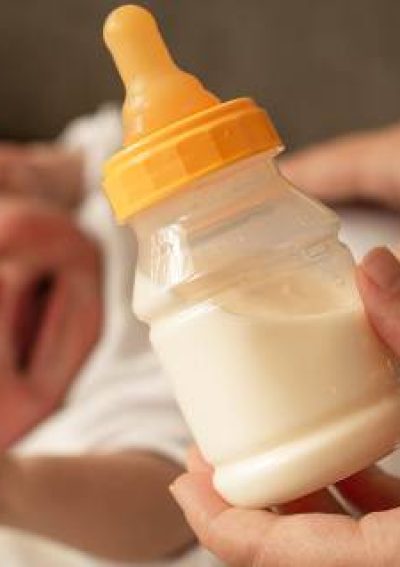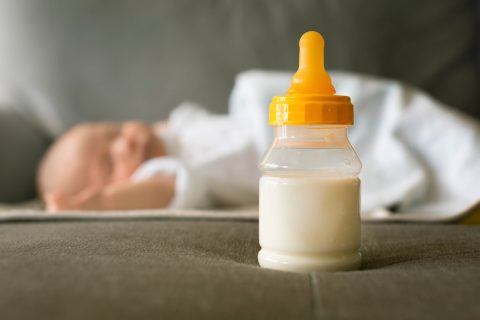Baby Formula and NEC
Necrotizing enterocolitis (NEC) is a severe intestinal inflammation that mainly affects premature or ill newborns. The condition can result in tissue damage and serious complications. Feeding with breast milk instead of formula can significantly lower the risk of developing NEC.

What Is NEC?
Necrotizing enterocolitis, commonly known as NEC, is a medical condition that causes intestinal inflammation in newborns. While it can affect any infant, premature or ill babies are at greater risk.
Inflammation caused by NEC can lead to several complications, such as organ problems, intestinal tissue death, bowel obstruction, nutrient malabsorption, vitamin deficiencies, feeding difficulties and bacteria overgrowth. Bacteria can enter holes in the intestine, leading to deadly infections, such as sepsis.
Treatments for NEC include antibiotics and surgery. Doctors may remove a part of the baby’s bowel and check for holes in the intestinal tract. Babies will stay in the hospital for observation and treatment. Once babies are eating and not losing weight, they may be able to go home.
- Abdominal pain
- Bloody stool
- Changes in blood pressure, breathing and heart rate
- Inability to gain weight
- Lethargy
- Refusal to eat
- Swollen, puffy abdomen
- Trouble eating
- Unstable body temperature
- Vomit that may be yellow or green
Babies with severe or worsening NEC may develop generalized swelling or fluid retention and low blood sodium levels. As NEC worsens, babies develop kidney problems and excessive potassium in the blood.
What Is the Link Between Baby Formula and NEC?
A study funded by the National Institutes of Health, published in the Journal of the American Medical Association, found that premature babies given donated human milk had a significantly lower risk of developing NEC than those fed formula.
Specifically, only 4.2% of the babies who received human milk developed NEC, while the rate was 9% for those on formula.
The study included 483 babies born before 29 weeks of pregnancy or weighing less than 2.2 pounds. This study provides substantial evidence that using donated human milk can help protect premature babies from NEC.
One of the first studies to link baby formula to NEC was a 1990 study that found premature babies fed formula were up to 10 times more likely to develop NEC. Breast milk didn’t show the same risk, and researchers have found that human breast milk may reduce the risk of NEC.
Researchers have hypothesized that antibodies, growth factors and immune cells in breast milk may protect a premature baby’s gut, which may prevent NEC. Cow’s milk baby formulas may be more challenging to digest and could cause inflammation that contributes to NEC, but more studies are needed.
Which Babies Are Most at Risk for NEC?
Premature babies and babies who are sick or born with birth defects have a higher risk of developing NEC. It’s most common in preemies born before 37 weeks, according to the National Organization for Rare Disorders.
Formula feeding with cow’s milk baby formula can further increase the risk.
- Birth before the 37th week of pregnancy
- Birth weight of under 5.5 pounds
- Feeding through a stomach tube
- Formula feeding with cow’s milk baby formula
- Hospital bacterial outbreaks
- Infections
- Low blood oxygen levels at birth
- Serious illness
- Transfusions
About one in 1,000 premature babies and about one in 10,000 full-term babies may get NEC. Most babies develop NEC while still in the hospital.
In September 2024, the Necrotizing Enterocolitis in Preterm Infants Working Group published a report outlining several research priorities.
The working group noted that NEC is a complex condition influenced by various risk factors. They stressed the importance of research to improve human milk production, enhance its positive qualities and address the inequalities in access to donor milk.
Feeding premature babies mother’s milk or human milk from a donor may lower the risk of NEC.
Which Formulas Can Cause NEC?
Cow’s milk formulas — such as Enfamil, Similac and other brands — have the greatest chance of causing NEC compared to breast milk. A July 2022 animal study in Frontiers in Pediatrics found that some preterm baby formulas may be more damaging to the gut than others.
“Our findings indicate that not all preterm formulas are the same, and different formulations can have varying effects on intestinal inflammation, apoptosis and microbiome composition,” the study authors wrote.
For example, researchers found that Similac Special Care caused more intestinal injury than NeoSure. Similac Special Care is a popular formula for preemies in the neonatal intensive care unit because it’s designed to help them grow and heal. NeoSure is a catch-up growth formula for premature babies who have already gone home from the hospital.
Have Any Baby Formulas Been Recalled?
In February 2022, Abbott issued a baby formula recall for Similac, Alimentum and EleCare after some babies died of Cronobacter sakazakii infections. All affected formulas came from Abbott’s Sturgis, Michigan, plant.
Abbott closed the plant to investigate bacterial contamination. The U.S. Food and Drug Administration has since inspected the plant and found Cronobacter in certain areas around it but not in the product samples it tested. The recall and plant closure contributed to a national baby formula shortage, but the plant is back open.
In October 2022, Abbott issued another recall for certain ready-to-feed liquid formula lots because some bottle caps might not have been appropriately sealed. Improperly sealed bottles could cause spoilage, which could lead to stomach problems in children who consume the formula.
Brands in this recall include Similac Pro-Total Comfort, Similac 360 Total Care, Similac 360 Total Care Sensitive, Similac Special Care 24, Similac Stage 1, Similac NeoSure, Similac water (sterilized) and Pedialyte electrolyte solution.
NEC Baby Formula Lawsuits
Parents whose premature babies developed NEC after consuming Enfamil or Similac have filed baby formula lawsuits against manufacturers Abbott Laboratories and Mead Johnson.
Lawsuits claimed that the companies knew or should have known that cow’s milk baby formula could cause NEC in preterm infants. However, manufacturers continued to sell the formula and failed to warn parents and doctors.
In August 2022, judges consolidated baby formula lawsuits nationwide in Illinois multidistrict litigation. As of December 2025, 774 cases were pending.
The first bellwether trial is scheduled for May 2025.
24 Cited Research Articles
Consumernotice.org adheres to the highest ethical standards for content production and references only credible sources of information, including government reports, interviews with experts, highly regarded nonprofit organizations, peer-reviewed journals, court records and academic organizations. You can learn more about our dedication to relevance, accuracy and transparency by reading our editorial policy.
- U.S. Judicial Panel on Multidistrict Litigation. (2024, November 1). MDL Statistics Report. Retrieved from https://www.jpml.uscourts.gov/sites/jpml/files/Pending_MDL_Dockets_By_Actions_Pending-November-1-2024_0.pdf
- U.S. Department of Health and Human Services. (2024, September 16). Necrotizing Enterocolitis (NEC) in Preterm Infants Working Group of the National Advisory Council of Child Health and Human Development (NACHHD) Report to Secretary, Department of Health and Human Services. Retrieved from https://www.nichd.nih.gov/sites/default/files/inline-files/2024.09.16_NEC_WG_report_FINAL.pdf
- National Institutes of Health. (2024, February 7). Science Update: Preterm Infants Fed Donor Milk Had Fewer Intestinal Complications Than Formula-Fed Infants. Retrieved from https://www.nichd.nih.gov/newsroom/news/020724-preterm-human-milk-study
- Colaizy, T.T. (2024, January 30). Neurodevelopmental Outcomes of Extremely Preterm Infants Fed Donor Milk or Preterm Infant Formula. Retrieved from https://jamanetwork.com/journals/jama/fullarticle/2814657
- Abbott. (2022, October 14). Abbott Voluntarily Recalls Certain Lots of 2 fl. oz./59 mL Bottles of Ready-to-Feed Liquid Products; Recall Is Not Expected to Impact U.S. Infant Formula Supply. Retrieved from https://www.abbott.com/corpnewsroom/nutrition-health-and-wellness/voluntary-recall-of-certain-2-fl-oz-liquid-products.html
- American Academy of Family Physicians. (2022, August). Necrotizing Enterocolitis. Retrieved from https://familydoctor.org/condition/necrotizing-enterocolitis/
- Rao, K. et al. (2022, July 6). Effect of Various Preterm Infant Milk Formulas on NEC-Like Gut Injury in Mice. Retrieved from https://www.ncbi.nlm.nih.gov/pmc/articles/PMC9299064/
- Perks, P.H., Borowitz, S.M. & Swanson, J.R. (2022, January). Nutritional Management of Infants with Necrotizing Enterocolitis. Retrieved from https://med.virginia.edu/ginutrition/wp-content/uploads/sites/199/2022/01/January-2022-Infants-with-NEC.pdf
- Wolters Kluwer. (2022). Modified Bell Staging Criteria for Necrotizing Enterocolitis (NEC) in Neonates. Retrieved from https://www.uptodate.com/contents/image?imageKey=PEDS%2F54166&topicKey=PEDS%2F5019&source=outline_link
- National Institute of Child Health and Human Development. (2021, December 16). What Are the Symptoms of Necrotizing Enterocolitis (NEC)? Retrieved from https://www.nichd.nih.gov/health/topics/nec/conditioninfo/symptoms
- ClinicalTrials.gov. (2021, November 16). Infant Formula Feeding and Necrotizing Enterocolitis in Newborns. Retrieved from https://clinicaltrials.gov/ct2/show/NCT05121753
- Savarino, G. et al. (2021, November 14). Necrotizing Enterocolitis in the Preterm: Newborns Medical and Nutritional Management in a Single-Center Study. Retrieved from https://ijponline.biomedcentral.com/articles/10.1186/s13052-021-01180-8
- Worsley, C. (2021, November 10). Necrotizing enterocolitis. Retrieved from https://radiopaedia.org/articles/necrotising-enterocolitis-1
- Cigna. (2021, September 8). Necrotizing Enterocolitis. Retrieved from https://www.cigna.com/knowledge-center/hw/medical-topics/necrotizing-enterocolitis-hw44299
- Cleveland Clinic. (2021, May 18). Necrotizing Enterocolitis (NEC). Retrieved from https://my.clevelandclinic.org/health/diseases/10026-necrotizing-enterocolitis
- National Library of Medicine. (2021, April 14). Necrotizing Enterocolitis. Retrieved from https://medlineplus.gov/ency/article/001148.htm
- Zozaya, C. (2020, May 13). Incidence, Treatment, and Outcome Trends of Necrotizing Enterocolitis in Preterm Infants: A Multicenter Cohort Study. Retrieved from https://www.frontiersin.org/articles/10.3389/fped.2020.00188/full
- Quigley, M., Embleton, N.D. & McGuire, W. (2019, July 19). Formula Versus Donor Breast Milk for Feeding Preterm or Low Birth Weight Infants. Retrieved from https://pubmed.ncbi.nlm.nih.gov/31322731/
- Nemours KidsHealth. (2018, October). Necrotizing Enterocolitis. Retrieved from https://kidshealth.org/en/parents/nec.html
- Shulman, J. et al. (2017, January). Current Knowledge of Necrotizing Enterocolitis in Preterm Infants and the Impact of Different Types of Enteral Nutrition Products. Retrieved from https://www.ncbi.nlm.nih.gov/pmc/articles/PMC5227976/
- National Organization for Rare Disorders (NORD). (2015). Necrotizing Enterocolitis. Retrieved from https://rarediseases.org/rare-diseases/necrotizing-enterocolitis/
- Penn, A.H. et al. (2012, September 24). Digested Formula but Not Digested Fresh Human Milk Causes Death of Intestinal Cells in Vitro: Implications for Necrotizing Enterocolitis. Retrieved from https://www.nature.com/articles/pr2012125
- Children’s Hospital Los Angeles. (n.d.). Necrotizing Enterocolitis. Retrieved from https://www.chla.org/necrotizing-enterocolitis
- UPMC Children’s Hospital of Pittsburgh. (n.d.). Necrotizing Enterocolitis Symptoms and Treatment. Retrieved from https://www.chp.edu/our-services/transplant/liver/education/liver-disease-states/necrotizing-enterocolitis
Calling this number connects you with a Consumer Notice, LLC representative. We will direct you to one of our trusted legal partners for a free case review.
Consumer Notice, LLC's trusted legal partners support the organization's mission to keep people safe from dangerous drugs and medical devices. For more information, visit our partners page.
844-763-0072

